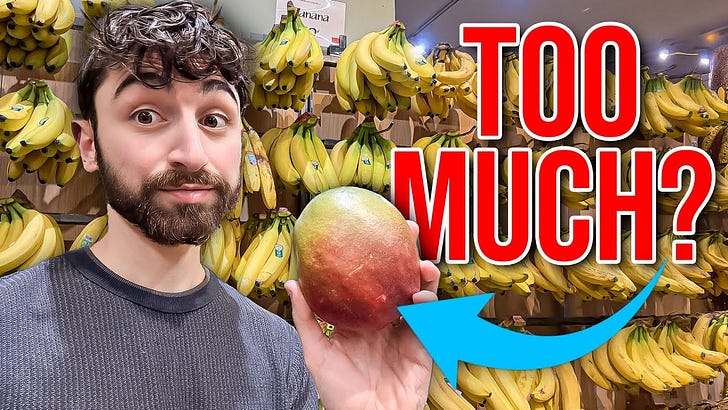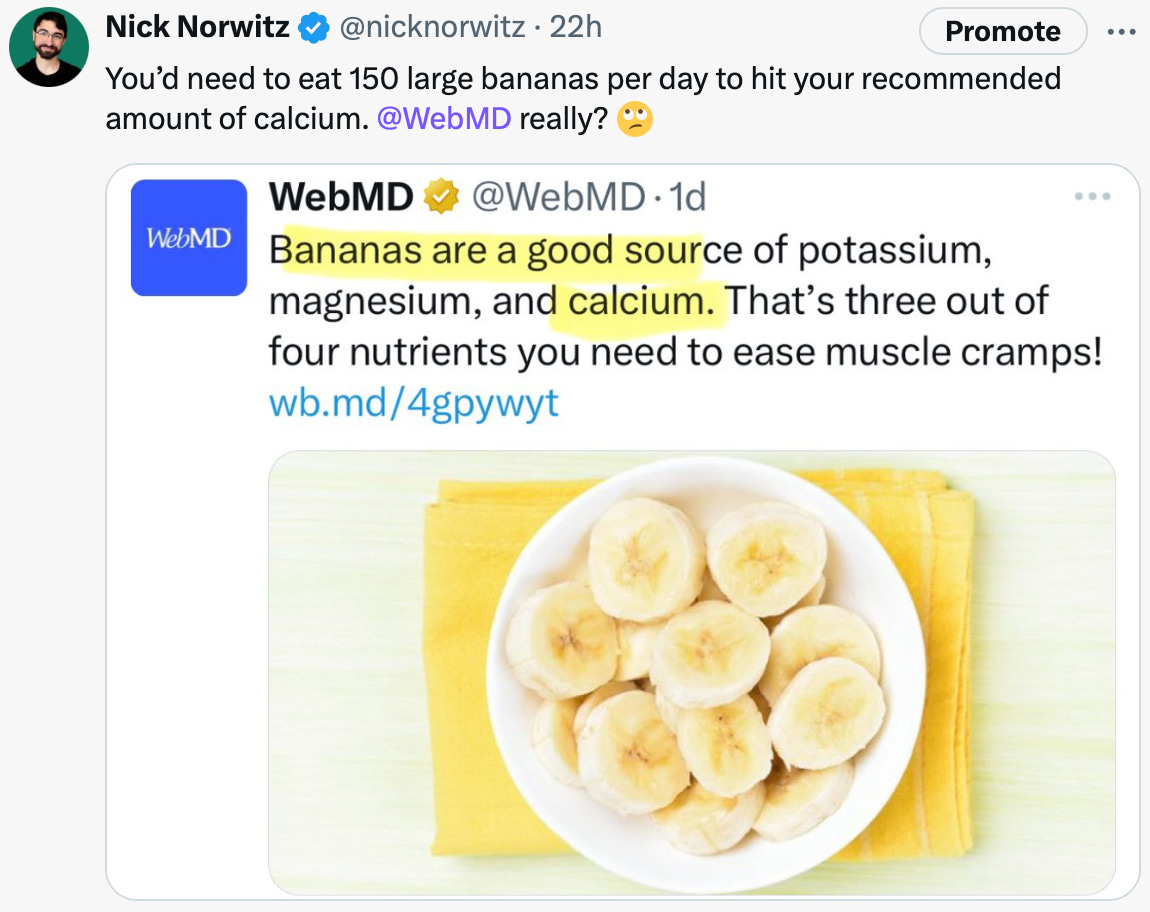Is Fruit Healthy? And, How Much is Too Much?
These aren’t easy questions to answer. But in this video, we will weigh into the debate and dissect these questions with the critical thought they deserve.
Is fruit healthy? And, how much is too much?
These aren’t easy questions to answer. But in this video, we will weigh into the debate and dissect these questions with the critical thought they deserve.
This content is now also covered in a video. If you prefer to watch, click below. Otherwise, read on!
To give you a roadmap:
We will start by discussing fructose and explain why the fructose in fruit is contextually different than fructose in many processed foods.
We will then review why the scientific literature on this matter can be misleading.
Finally, will end with the practical guide, helping you to rank fruits based on various parameters.
1. Fructose vs Fruit
Fructose is a unique metabolically harmful molecule, acting in the liver to promote metabolic syndrome, depleting cells of energy and harming mitochondria, and potentially even enhancing the growth of certain cancers.
But does that mean fruit is bad?
Perhaps counterintuitively, No.
The negative effects of fructose depend on its metabolism in the body, starting with the liver as the first metabolizer after absorption in the intestines.
However, the intestines have a way to transform fructose into other molecules, glucose and organic acids, before fructose gets to the liver. Below you can see data from a tracer study showing that most fructose fed to animals is present in the small intestine (C), but is transformed into other molecules before it gets to the liver (G).
Higher fructose doses as in a sugar sweetened beverages can be harmful, since they exceed the capacity of the body to filter and transform the fructose, leading to spillover to the liver.
The authors of this paper write:
“[T]he balance between fructose consumption and intestinal fructose clearance capacity determines liver exposure to dietary fructose and thereby fructose toxicity.”
The next question is: How much fructose is too much?
The upper bound is probably around 1g/kg, which is quite a high threshold. For me, that would be on the order of 2 full mangos, which are the highest fructose fruit. However, that number is based on mouse data, and given their faster metabolisms relative to body size, I’d expect a lower threshold in humans.
What’s more, if you look at the curves from the study, you’ll note fructose in the portal vein (which means it spilled over past the intestines and is en route to the liver) starts to rise around 0.25g/kg even in mice. (The “Nick equivalent dose” being half a mango)
But it gets even more complex.
Intestinal fructose processing and clearance is also influenced by prior exposures. So, in reality – since I eat a very low carb diet – my threshold for fructose is likely much lower. For a fruitarian, I suspect their intestines would be adapted to a higher fructose tolerance.
So, combining all this and coming up with rough numbers for you, I would suggest a daily threshold of 0.5g/kg for someone eating a standard mixed diet and 0.25 g/kg, at a liberal level, for someone on a low-carb diet who doesn’t normally eat sugar or fructose.
*Nuance Note: In case you’re wondering, high fructose corn syrup and sucrose are metabolically equivalent in this respect, containing similar proportions of fructose. The authors write, “sucrose and free fructose are metabolically equivalent” with respect to the process we just described.
2. Why The Literature Can Be Misleading
It’s surprisingly difficult to assess the impact of fruits on health.
This is largely due to the fact that, in large scale epidemiological studies, there is ‘healthy user bias,’ where those who eat more fruit tend to live overall healthier lifestyles.
Additionally, fruits gets ‘lumped’ such that a serving of raisins and a serving of organic wild blueberries are counted as similar, which can further bias the data.
And, in shorter-term randomized controlled trials, where they exist, one needs to ask whether short-term effects on biomarkers translate in to long term benefits on health.
Also, whether results in one population translate to another. An athlete or generally healthy person having a banana before a run is very different than a person with diabetes chopping a banana into their morning brown sugar oatmeal.
Finally, we need to consider the comparator. If the comparison is the Standard American Diet, and increased fruit intake displaces fruit juice, candy, and donuts, then we can of course expect health benefits. But that doesn’t mean fruit intake is metabolically optimal in all circumstances, nor that a bowl of fruit is a healthier breakfast than eggs and bacon, or a healthier dessert than a cheese platter.
For these reasons, the scientific literature on fruit can be manipulated to reinforce particular narratives, not because the data are watertight, but because the practicalities and deficiencies of the literature hinder us from asking certain questions like, “Does eating a very high mango diet increase risk of cancer X as compared to eating a ketogenic diet rich in and isocaloric amount of bacon?”
As much as I’d love that trial, it’s not happening.
3. Fruit Guide
Although fruit can be ranked along different parameters, no single parameter gives a whole picture. However, for the sake of the exercise, here are fruits ranked in terms of fructose content, glycemic index, and fiber content.
Of note, these ranking will shift slightly depending on the units used, whether they are ranked per Calorie, per serving etc.
Fructose
The highest fructose fruit is mango. Other higher fructose fruits include jackfruit, grapes and watermelon.
Lower fructose fruits are berries, kiwi, and citrus fruits. And of course, the non-sweet low-carb fruits like coconut, avocado and olives.
Glycemic Index
Medium-high glycemic index fruits include watermelon, pineapple, mango, and banana. Basically, any very sweet tropical fruit will have a higher glycemic index. And most dried fruit is a sugar bomb that is typically less than ideal, metabolically.
Lower glycemic load fruits are berries and grapefruit.
Fiber
The highest fiber fruits – after the king of high-fiber fruits, the avocado – include wild berries, pomegranate and basically anything where you eat the skin (grapes excluded).
Word of Caution on Vitamins & Minerals
Of course, different fruits have different vitamin and mineral profiles. For example, citrus fruits, strawberries and kiwis are rich in vitamin C.
But a note of caution. Be careful when googling “high vitamin/mineral X food or fruit,” as you can get profoundly misleading results.
For example, google will tell you mango is rich in vitamin A, but a 1 cup of mango (165 g) contains only 89 ug of vitamin A precursor, or 10% of your daily value. By comparison, just 1 ounce (28g) of beef liver contains >2000 ug of Vitamin A. So, while mango might be relatively high in vitamin A for a fruit, it’s not a high vitamin A food.
I also saw a tweet recently suggesting guava was a high protein fruit.
Or, this joke of a tweet from WebMD claiming Bananas are a good source of calcium. One large banana has about 7 mg of calcium. So, you’re need to eat about 150 large bananas per day to get your recommended intake.
Tip: If you’re interested in the nutrient in a food, what I recommend is googling the absolute amount and cross-referencing that to the recommended daily allowance, where applicable.
Summary
We can reconcile the fact that fructose is metabolically harmful beyond its calorie load, and that fruit might not be harmful, when we consider how fructose is transformed in the small intestine before it hits the liver.
Yes, dose does matter and fructose from blueberries is not the same as fructose from a soda – not from the liver’s perspective.
Fruit can be included as part of a healthy diet, but it is not necessary for a healthy diet. In choosing what fruits are best for you consider what variables matter to you (e.g. fructose content, glycemic index, presence of certain nutrients), while keeping in mind that no single parameter captures the impact of a whole food.
Apply the N = 1 approach. By this I mean, observe how eating food or fruit X makes you feel and what it does to your biomarkers in as controlled a manner as possible. In the end, this matters most to you as an individual.







Yes, I remember reading about the Warburg effect which was first proposed almost 100 yrs ago, whereby cancer cells preferentially use glucose as their energy source. Also about Thomas Seyfried's metabolic theory of cancer. Perhaps we got so focused on cancer as a genetic disease that we stopped looking at other options. Often happens in science, but as you say, "stay curious". Theoretically, intermittent fasting and a strict glucose-free ketogenic diet could be helpful as a cancer treatment or even as an add-on treatment.
Hi, Nick! Thanks for your work.
What you would recommend to a person understanding more about the scientific studies? I had my college in the health area but didn't learn how to interpret and think by my own.